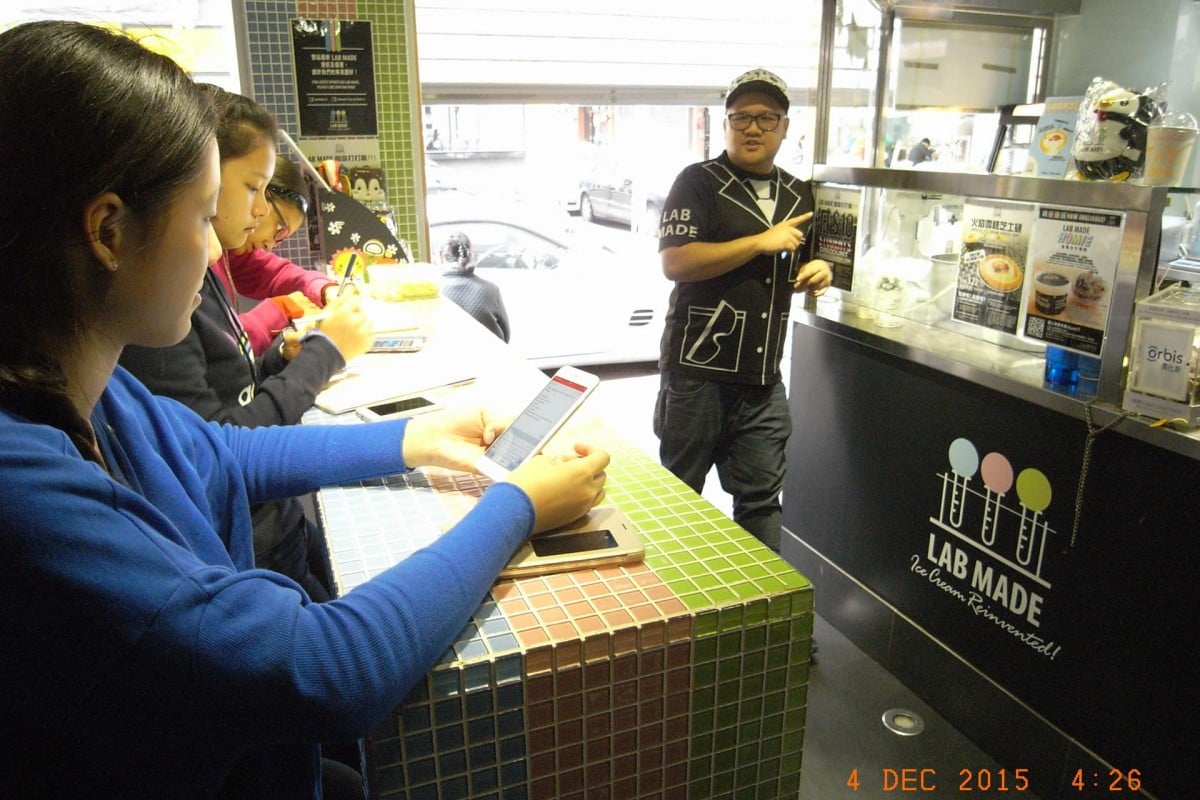
Ice cream made with liquid nitrogen has been trending for a while now, so last week, some junior reporters went to the dessert shop Lab Made to find out the science behind it …
 From left to right: Veronica Lin, Joyee Au Yeung and Madhavi Chakravorty learn science is fun from Ronnie.
From left to right: Veronica Lin, Joyee Au Yeung and Madhavi Chakravorty learn science is fun from Ronnie.Who doesn't love ice cream? The cool, creamy treat has been a firm favourite for years. But some places are making it even cooler, and it's all thanks to liquid nitrogen. Liquid nitrogen is a chemical that is often used for freezing foods because nitrogen is colourless, odorless and tasteless. You've probably spotted the distinct ice cream, sometimes called "instant ice cream", amidst clouds of smoke in shops around the city.
To find out how it's made, some of our junior reporters went to Lab Made in Tai Hang for a workshop with owner Ronnie Cheng, who taught them about the science of nitrogen and let them try some Christmas flavours.
Cheng, who started out with just one ice cream shop in Tai Hang, now has two more branches on Hong Kong Island and in the New Territories. Few people are more qualified to give us the inside scoop on instant ice cream than he is.
Smooth, creamy ice cream
Winter has arrived in Hong Kong, but the cold season never stops a true foodie. Ever wondered how your all-time favourite ice cream could be improved? Look no further, as the answer is as simple as using liquid nitrogen to cool the ice cream quickly, so that no ice crystals form and the ice cream's texture becomes smoother.
As a foodie, I can confirm that I found the pandan ice cream at Lab Made smoother than any I have tasted before. A pine wreath made from green meringue, featuring brightly coloured decorations made of sugar, was put on top, making it much more festive!
The pandan leaf is used across much of Southeast Asia for cooking. It tastes a bit like coconut, but with a hint of citrus, and some nutty undertones. This made for quite a special flavour and it also gave the ice cream a distinctly Asian vibe. The toppings - rich toffee sauce and chocolate sauce - were absolutely delicious.
The festive Christmas special is also delightful: Rudolph the red-nosed reindeer recreated with chocolate ice cream, whipped cream, pretzels, and tiny chocolates for eyes. This ensures that Rudolph is not only loved by all the other reindeers, as in the famous Christmas song, but also by all sweet-toothed foodies!
As well as awesome ice cream, Lab Made is also home to Squly and friends: a group of cute animal cartoon characters created by local designers. So, who wants directions?
Joyee Au Yeung, St Paul's Co-educational College
An experience for all the senses
Liquid nitrogen brings ice cream lovers' taste buds one step closer to heaven, as it improves every aspect of what everyone loves about the frozen treat, while shortening the time to make it to around a mere 30 seconds.
So why is liquid nitrogen so great? It has a very low boiling point of -196 degrees Celsius. Because it's so cold, it freezes ice cream mixture almost instantly when it comes into contact with it. So, the originally excruciating hours spent freezing ice cream the traditional way are replaced by 30 seconds of wonder, excitement and amazement.
But does this scientific way of making ice cream affect the taste?
The answer is yes, but it's not a bad thing. On the contrary, liquid nitrogen ice cream tastes even better than the traditional stuff. This is where science steps in again: due to the low temperature of the liquid nitrogen, the ice cream freezes before it even has a chance to form ice crystals, which are frequently found in homemade and supermarket-bought ice creams, and which add unwanted crunchiness and frost to its texture.
The highlight of the liquid nitrogen ice-cream-making process is the interactive experience the shop offers customers. Instead of making the ice cream behind closed doors at factories, customers get to see the immediate solidification, along with massive amounts of smoke and the sizzling sound effects that come from the mixer, which are bound to stimulate all of your senses.
Put simply, "lab-made" ice cream provides a fun experience that's even tastier than it looks!
Veronica Lin, Hong Kong International School
Refining the art of ice cream making
Cheng did a quick demonstration to show how liquid nitrogen behaves - when a leaf is dropped into liquid nitrogen, it turns brittle. But when he poured a bit on my hand, it felt cool! That doesn't mean you should go around playing with liquid nitrogen, as it can be very dangerous; but when handled properly it is a lot of fun.
During the workshop, we got to make the ice cream with liquid nitrogen, by adding a huge chunk of liquid caramel ice cream to an electric mixing bowl and pouring a bit of liquid nitrogen into the mixture. It was so satisfying to see so much foam being created when the liquid nitrogen hit the mixture in the bowl.
Liquid nitrogen ice cream is more delicious than normal ice cream and only takes about 30 seconds to 1 minute to make.
We also tried two special Christmas flavours of ice cream made by Cheng himself - cookies with chocolate syrup, and pistachio. They both tasted sweet and yummy, and perfectly captured the festive spirit.
We decorated the ice creams with pretzels, chocolate and marshmallows. My favourite flavour was the chocolate cookie one.
The workshop was a great opportunity to talk to someone so passionate about dessert, and who is constantly thinking of innovative ways to develop and refine the art of making ice cream.
Madhavi Chakravorty, French International School